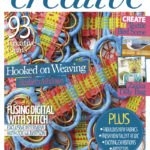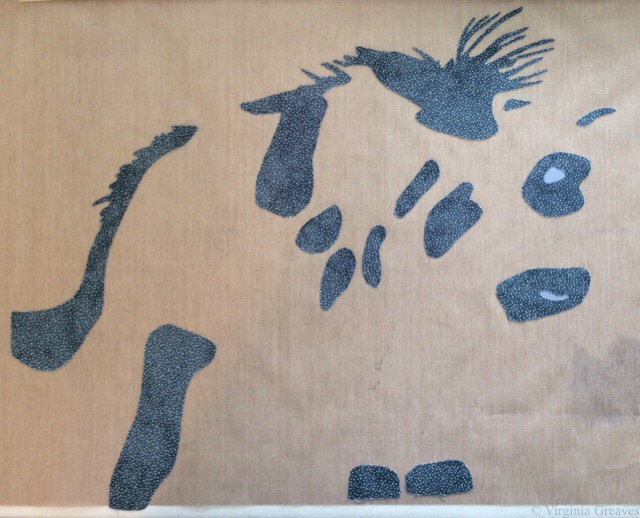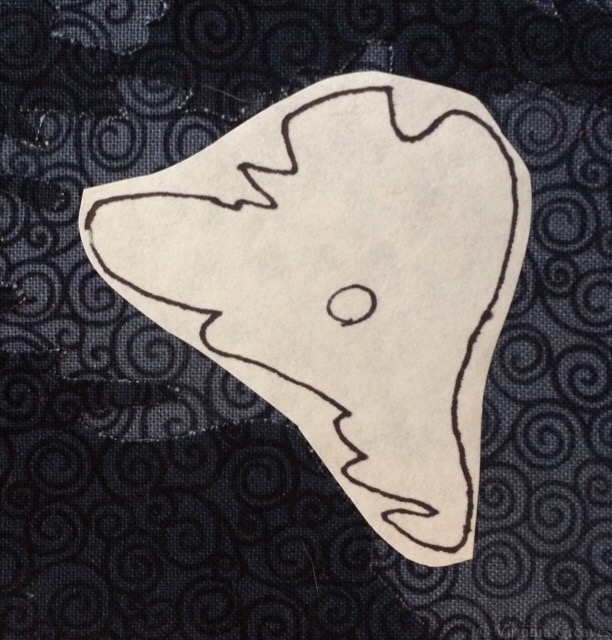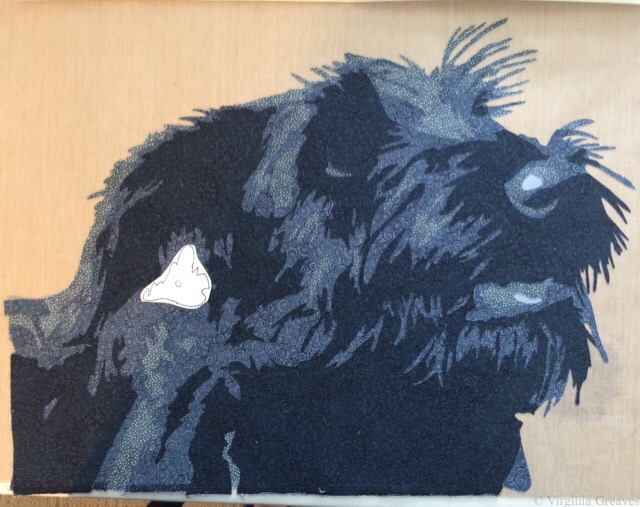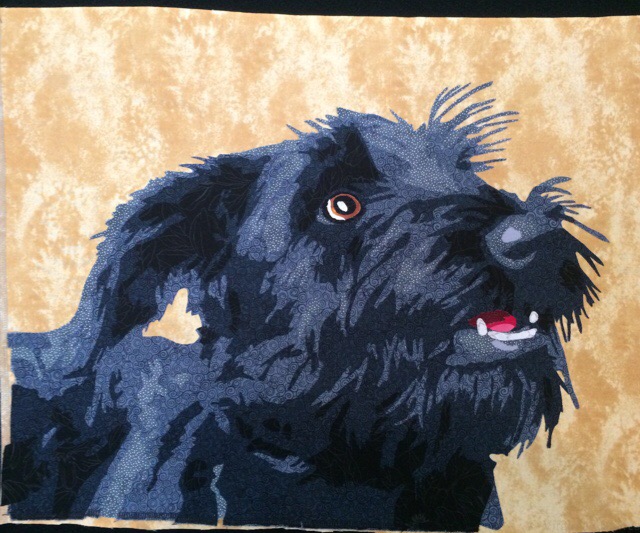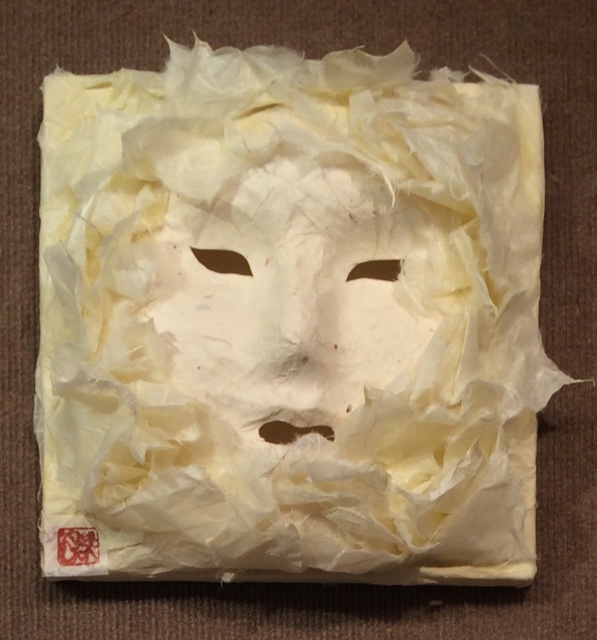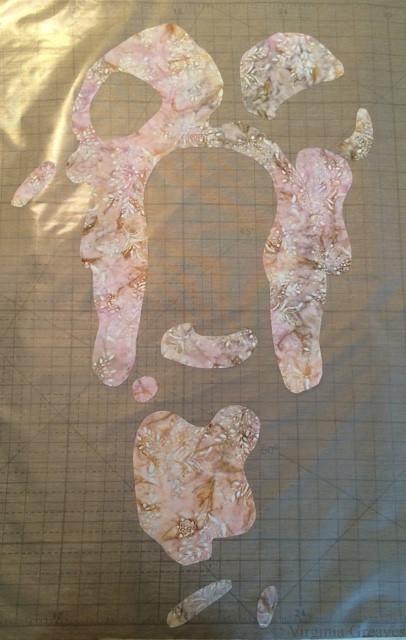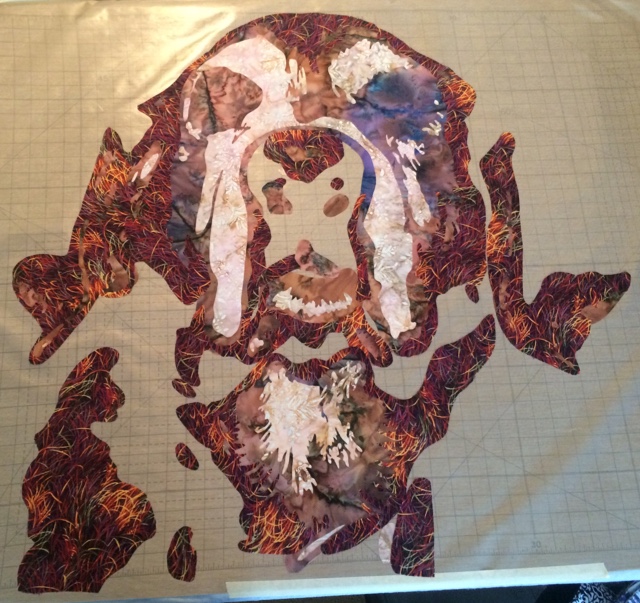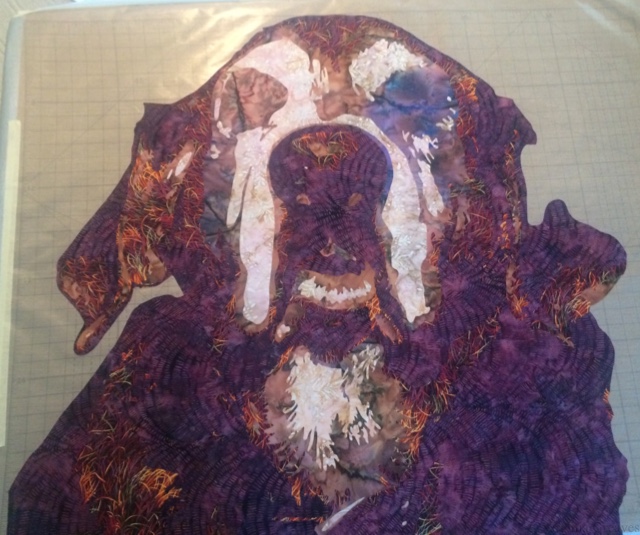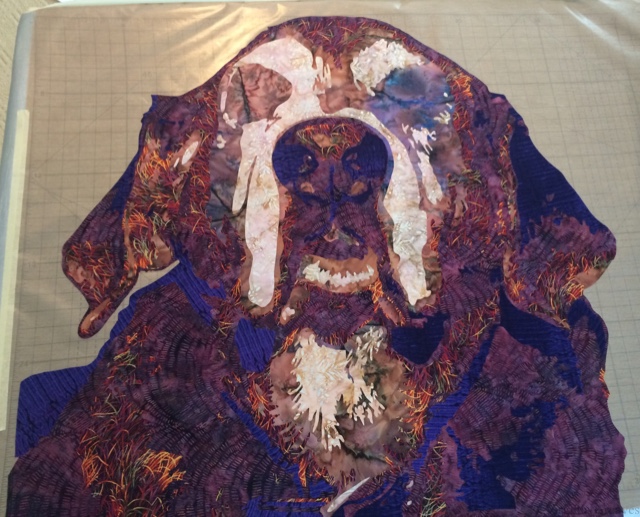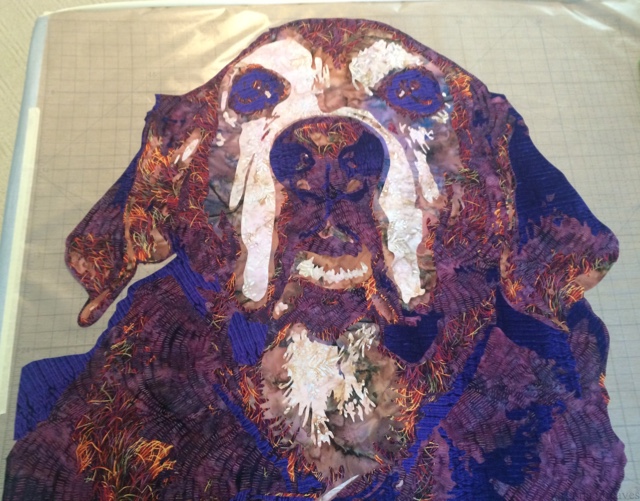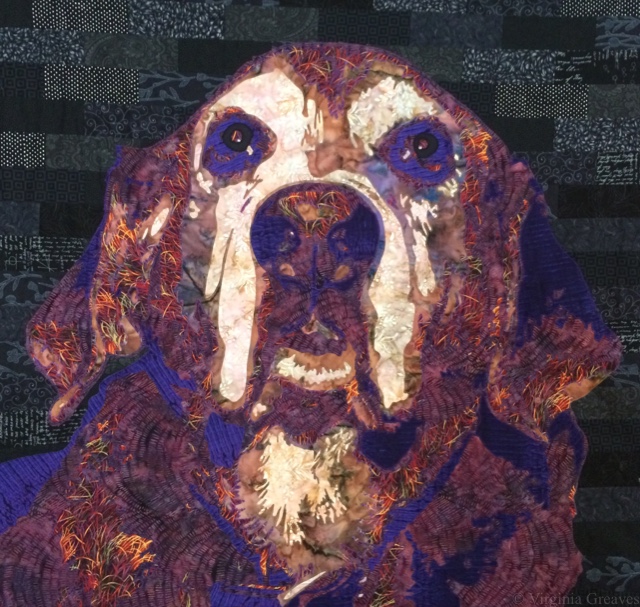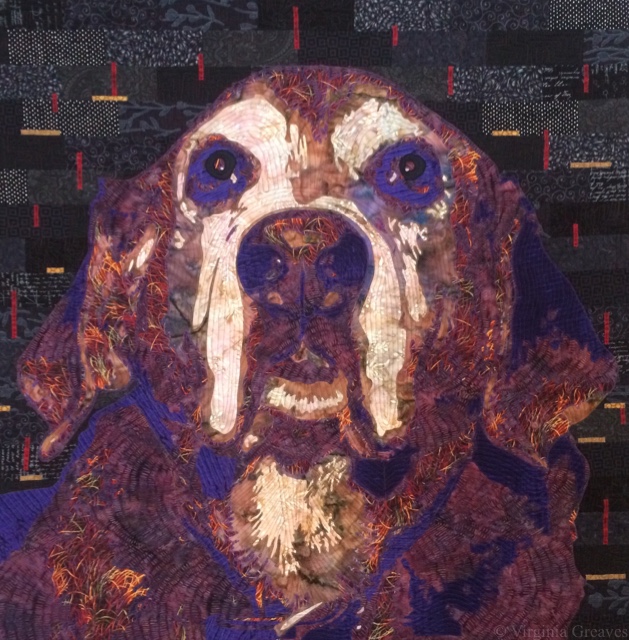Exhibition

Making Tattoo
0Woohoo! My first piece in Dinner@8! I know there are a lot of you that can’t comprehend what a big deal this is, but it’s kind of like winning the lottery. It’s a juried invitational show, so I had to apply to be a part of the Dinner@8 group in order to be invited to make a piece for the current year’s show. After I was accepted, I made a piece according to the theme, which this year was Personal Iconography: Graffiti on Cloth.
I haven’t shown the piece in process on the website because that’s a no-no in this show. Virgin rules, except you can post after acceptances go out.
I’ll admit that I was stumped by this year’s theme. My goal, just as I did the Yvonne Porcella piece (Yvonne in the Garden), was to make a piece that was wholly in my style while still working within the framework of the theme, but I knew that doing that with this theme was going to be hard. I knew that I was going to make a portrait of a person, and I spent some time thinking about how tattoos are so personal and would work well within the theme. My daughter has several tattoos, and she spends a lot of time considering the symbology of each piece and finding the right artist before she gets them. I wanted to honor that, but I also knew that finding a female model would be hard. I envisioned a back shot with the main tattoo on the arm. I’m not entirely sure why, but it seems to me to be a deeply personal pose, enough that I didn’t know anyone personally that I felt I could ask. And really, who’s always available? (Me.) Thank goodness I have a remote control for my camera. I set it up in my studio, and by the end of one afternoon, I had a series of shots I could work with to create what I had in my mind.
I started with the shoulders and back first since the hair would drop over the back. I usually start with the face, but in this instance, the shoulders made more sense. This is the first couple of values.
This is the 3rd value. I ran out of the fabric — or rather ran short on it. I knew I needed enough to cut out for the face and decided that I needed to supplement with a fabric that was close. I could use it on the extended arm and the change would be less visible. (This prompted a late night run to JoAnn’s as it was the only thing open at the time, & I was in the creative head space to keep moving forward.)
This is also the point at which I realized I needed to complete the hand along with the arm — and make sure I had enough fabric to do it as well.
And then I added the deeper values, a dark tan and a couple of dark blues — and then the black garment.
And then I started on the face using the same fabric. These are the first two, and you can just see the basic outline.
This is the 3rd value, the one that I ran out of. I’ve had this fabric for a long time, and I’ll have to try to replace it. (Never let anyone tell you that calicos don’t have value. They’re wonderful for faces.)
This is the 4th value. It inadvertently looks a little like horns, but really, that’s just my high forehead that will go under the hair.
The 5th value. You can tell I was working at night in this one.
And then the rest of the darkest values. I leave the main parts of the eyes and the mouth for the end, so at this point, she looks a little bit like a zombie. I did play around with the darks around the eyes a little bit. I naturally have very dark circles around my eyes, but it wasn’t aesthetically pleasing in the piece, so I backed off on the value a little. (This is part of what I call creative license. Do what’s best for the piece and don’t feel tied to exact duplication of the photograph.)
These are the eyes. Not quite right. I almost always freehand cut these nowadays.
And in this one, a darker blue around the rims of the irises and larger pupils. Then I made the teeth (or the suggestion of teeth) and the mouth.
I did go back later and make the eyebrow on the right darker.
I spent quite some time trying to figure out how I would do the tattoos. I wanted them to look like dotwork tattoos, and so screen printing seemed the way to go. I had, years ago, done some screen printing. What could go wrong? I drew the tattoos in my sketchbook, scanned them, skewed them in Photoshop so they would look as if they were on an arm and tilted across the back, and sent them to Fiber on a Whim to be burned to screens. After fusing my figure to a background and appliquéing it in place, I then screened them right on my piece. What was I thinking? The moon is clean but way too light, and the crow is a mess. I even have a paint blotch above the crow’s head.
With the moon, I just grabbed a fabric marker and filled in all of the light spots to clean it up.
The crow was much harder. I think it sat on my ironing board for at least a week while I thought it over. No use crying over split milk. I had leftover fabric, so I made a bunch of screens of the crow until I got a decent screen. I now have mad appreciation for anyone that screen prints, especially to fabric. It’s much harder than it looks to get a clean screen print.
On the finished piece, I cut out the crow and the blotch. I had to pick out appliqué stitches in two places. Those will be covered by the new crow.
Then I took the new crow, cut around the crow shape, and then fused it onto the arm. I also made a patch to fuse onto the area of the blotch that I had to cut out. Then I ran an appliqué stitch around the crow and the patch. I worried that it would be too obvious around the bottom area where the fabric value is darker, but it’s hardly noticeable on the final piece. There’s only about a quarter inch of light fabric around the crow, and it blends with the fabric it’s next to. In the end, it was a good solution to a difficult problem.
As I was making the piece, I thought it would be cool to add graffiti to the background. That’s why I went with a solid blue background. I even studied graffiti shapes and practiced lettering. I made the graffiti, but then I decided it was too much of an in-your-face interpretation of the theme — so I took them off. That was much worse. So I spent time thinking about the background — and about how I approach my work. In the end, I decided that I didn’t want to be safe, and leaving off the graffiti was safe. Keeping them on there gave the piece a vibrancy it didn’t have without them. So I played with their placement and added black outlines to them and some sparkly points.
You can see the final piece on the Tattoo page here.
Tattoo will premiere in the Dinner@8 exhibit at International Quilt Market & Festival in Houston this coming October/November.

Wash & Wax article in Be Creative
0
I Got Rejected from Quilt National ’17!
0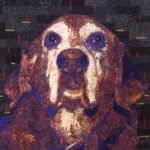 So I just got my email saying that my piece, Minerva, didn’t get into QN ’17, and I was talking to a friend of mine who also didn’t get in (who, incidentally, was in their last exhibit in ’15), and I started thinking — wouldn’t it be really cool to see all the amazing work that didn’t get into QN ’16. I mean, the pieces I know that didn’t get in are spectacular! The acceptance rate was just slightly over 11% — imagine seeing the awesome work that isn’t going to QN ’17!
So I just got my email saying that my piece, Minerva, didn’t get into QN ’17, and I was talking to a friend of mine who also didn’t get in (who, incidentally, was in their last exhibit in ’15), and I started thinking — wouldn’t it be really cool to see all the amazing work that didn’t get into QN ’16. I mean, the pieces I know that didn’t get in are spectacular! The acceptance rate was just slightly over 11% — imagine seeing the awesome work that isn’t going to QN ’17!
So I’m going to do this — I’m going to start a gallery page “I Got Rejected From Quilt National,” and I’m inviting other artists that weren’t accepted to send me a pic of their work.
You can email it to me at ginny@virginiagreaves.com with subject line “QN” — and please make the pics 1800 px on the longest side.
And if I get more than just a couple, I’ll post the page for all to see.
Even if you don’t want to participate, if you received a rejection, know that you’re in good company. Keep going. Enter your work somewhere else. There are lots of other shows out there.
UPDATE: I created a FB group, Quilt National Salon des Refuses. It’s a public group so you can post there directly.
https://www.facebook.com/groups/1237861046301053/

2016 IQA Auction
0This year, I was again asked to create a piece for IQA’s Celebrity Mini Quilt Silent Auction. It’s an honor to be invited, and I try to support IQA as much as I can. They have helped sell my work, and they have bought my work for their private collection. That’s a lot. So once a year, I stop what I’m doing and create something for them for their auction.
This year, I wanted to make a piece that was more like the rest of my work The last two years, the pieces have been tiny. So I wanted something that was a little bigger but still small that would give more of a sense of my personal style. I finally decided that the broadest appeal to the general public would be a dog or cat, and given that I don’t have a cat and people don’t typically take their cats out in public in the same way that dog owners do, I chose a pic from my catalogue of dog pics.
I found this pic of a black dog that I’m sure I took during a lacrosse game. I have no idea who he belonged to, but he was cute so I took his picture. I think he’s a schnauzer. I zoomed in on his face and loved his quirky expression.
In keeping with my new penchant to use unexpected fabrics (but then also working only from my current stash), I decided that the best way to do a black dog would be to use blue fabrics. Gray doesn’t have the same character as the blue grays. So, like with Minerva, I wanted to create a black dog using blue fabrics — but the end result should look like a black dog, not a blue one.
This shows the 1st two values on my pressing sheet.
This is my 3rd value. You’ll see in a minute, there was a hole for the space at the bottom of the ear that I forgot to cut out of this layer.
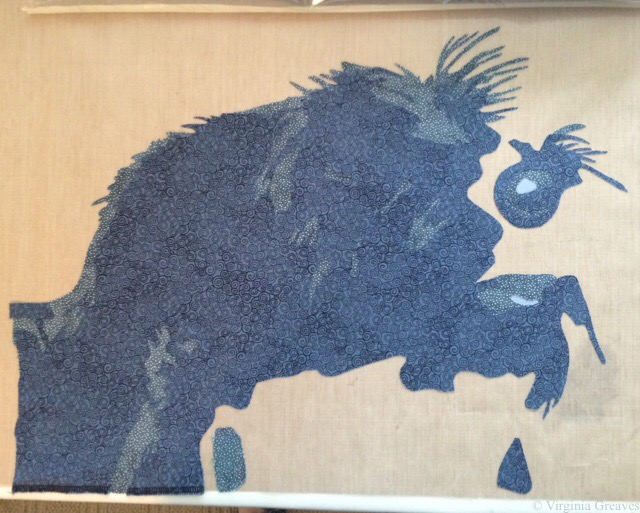
When I realized it, I traced the shape onto freezer paper and ironed it to the front.
You can see the freezer paper template in this one — which also shows the 4th value. There’s a lot more character in him now.
And then the 5th value was the actual pure black. He has a lot more dimension now — but he needs a proper mouth and eye.
There’s a little bit of tongue tucked in there and then a row of teeth and two fangs on either side of his gum line.
And then his eyeball. As I have often done lately, I constructed it as it was in the drawing made from the values in the pic — but then ripped it off and redrew it as it needed to be in order to look as it needed to look. There are some things you can finesse if they’re not quite right — the eye isn’t one of them.
And then I ripped the appliqué off the pressing sheet and cut out the freezer template to give me the space I needed on the underside of the ear. You can see the ear more clearly now, especially ironed on to the background fabric. This yellow was a nice contrast.
At this point, it isn’t appliquéd. I decided to appliqué stitch and quilt at the same time, so I sandwiched this rough top up and straight free-motion stitched around all of the shapes.
After the appliqué was done, it still needed more quilting to be evenly quilted — and of course the background had to be quilted.
The only thing I might do differently in the future, in terms of construction of a small piece, would be to pillowcase it so I wouldn’t have to add a facing to finish the edges. That took a while. But I opted against doing it because I thought this piece was a little big for that and I didn’t want any issues with it not laying flat or creating a tuck on the back. I wanted it to be perfect.
I snapped a few shots before sending him off in the mail — he’s due Thursday — so I cut it close but he’ll make in under the wire.
Let’s hope he goes to a good home. He’ll debut at the Silent Auction in Houston in November.
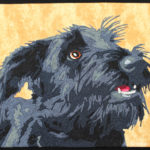 If you want to see the finished piece, he’s here.
If you want to see the finished piece, he’s here.

2016 Fierce Fibers
0Last week, we had our annual opening of Fierce Fibers at The Art Place in Marietta. Rebecca Reasons-Edwards and I have been co-curating this show together for six years. I’ve learned a lot from her, and we had a great time putting this show of local Atlanta fiber artists together this year. We had a great turnout at the opening reception last Thursday, but the show will hang through September 29th if you still want to go see it.
We had a Viewers Choice award, and it was a tie between two of my pieces, The Last Supper and The Abyss, which was a nice surprise. Thank you to everyone that came to the reception and voted.
And especially, thank you to all the artists that allowed us to hang your work in the show. It’s a beautiful exhibit and a great example of the amazing fiber work currently being done in Atlanta.
For the benefit of those that aren’t local to Atlanta, I’ve been asked to post pics of the show online. Enjoy!

The Rules Have Changed
2Many years ago, I entered Quilt National, and like many others, my piece was rejected. Since then, I haven’t entered again due to their virgin rules which said that the piece couldn’t have been displayed anywhere at all ever in any part online or on physical view in a public venue. I have always enjoyed showing my in progress work on my blog which disqualified anything I might want to enter.
But this year, in their infinite wisdom, the powers that be at Quilt National have changed their rules. They now allow social media marketing of your piece. They only require that the piece not have exhibited publicly in the US or been published.
And I have a piece that I’ve been working on most of the summer that I just finished, so I held my breath and entered it. We’ll see. Quilt National takes 3%, I believe, of their entries. In the past, they’ve been almost completely an abstract show, but in the last exhibit in ’15, there were a few illustrative pieces, so I’ve decided to try. You never know if you don’t try.
This has been a strange piece for me. I can do realism in fabric. That isn’t a stretch for me. But I’m to the point that I need more. I need my work to speak more. And so I’ve stepped out of my comfort zone. I drafted a picture of one of my dogs, but I couldn’t get excited about making her in realistic colors, so I chose wild ones. My base was purple. I even went down into pink for the latest shade.
It was my original intent to use Kaffe Fassett prints — but I still haven’t figured out how to makes those work. There are some fabulous artists that do, like Danny Amazons and Sophie Standing. I think my issue is one of scale. They work very large, and making the large Kaffe Fassett prints work in a very large piece is much easier than in a medium piece.
So as I went, I changed several fabrics.
This is how I began, a pink batik.
This shows the next two values, a batik that varies from a muddy pink to a blue purple and a print with red, purple, and yellow. This last one was my wild card. To me, it gives the impression of the spiky fur.
The fourth value is a deeper purple.
And the fifth value is the deepest purple.
And this is what she looks like after I went back and added the eyes. And I’m struck because I’ve used pink and purple, and yet she still comes across and orange and brown.
I made a black pieced background for her. At this point, I realized that she needed the deeper black in the pupil — the purple alone wasn’t giving quite enough depth.
And then I played with the background to make the piece come alive. My first thought was to add many narrow yellow strips on the black, but that became distracting. Someone suggested using some red too, and I played with placement until I came up with something that adds energy to the piece but doesn’t distract from the main subject.
It is about 36″ square which is what I would call a medium piece — but it’s large for the head of a dog. Its greatest impact is seen when you step back from the piece.
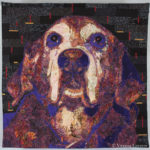 If you want to see it as completed, click on the thumbnail pic to the left or here.
If you want to see it as completed, click on the thumbnail pic to the left or here.
My intention was for her to be somewhat abstracted, and in some way, my experiment yielded something strangely more realistic. I think using the deep purples pulls on the Impressionistic background I learned from my mother’s work. I may continue to explore that in my next piece.

Closure and Grace
2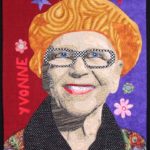 I have completed Yvonne in the Garden. She was surprisingly easy to do. I’ve reached a point where portraits are not difficult constructions for me. Giving the piece deeper meaning is more difficult, however, than the technical skill required to create a portrait. For Yvonne, after her portrait was completed, I was tasked with putting her in a space that was hers. To anyone familiar with her work, I have hopefully succeeded by drawing on the inspiration of her work. For Yvonne, red was a neutral so it was an obvious choice. She loved hot colors. When I didn’t have enough of the right red, I just supplemented with purple — which I think was actually pretty close to what Yvonne would do. I then freehand drew out her name and flowers and a few stars to give the feeling of her inhabiting one of her own pieces. Since her passing, I think she would be happy existing in a realm of her own imagination.
I have completed Yvonne in the Garden. She was surprisingly easy to do. I’ve reached a point where portraits are not difficult constructions for me. Giving the piece deeper meaning is more difficult, however, than the technical skill required to create a portrait. For Yvonne, after her portrait was completed, I was tasked with putting her in a space that was hers. To anyone familiar with her work, I have hopefully succeeded by drawing on the inspiration of her work. For Yvonne, red was a neutral so it was an obvious choice. She loved hot colors. When I didn’t have enough of the right red, I just supplemented with purple — which I think was actually pretty close to what Yvonne would do. I then freehand drew out her name and flowers and a few stars to give the feeling of her inhabiting one of her own pieces. Since her passing, I think she would be happy existing in a realm of her own imagination.
I currently have two pieces hanging at the Abernathy Arts Center in Sandy Springs, GA through June 17th — both The Canary and The Last Supper. The reception was more fun than I’ve had in ages. I believe I was the only fiber artist in the show, but I had a very warm reception from the other artists and a lot of interest in my subjects. I’m finding that putting clues in my work is definitely a successful way of drawing interest in a piece. The gallery was packed that night, and I was surprised there weren’t more people that approached me regarding my self-portrait, but later in the evening, as the crowd thinned, I had more people recognize me from my work.
And now here we are at summer. I think I counted 10 or 12 pieces that I’ve done in the last year which is double what I usually do. At this point, I’m entering shows — 3 on Sunday and a couple more to come in the next month. I think I’m going to take a breath now and consider my next piece. DD2 came home last night with a very large raven painting that she did in school, and it calls to me. I’ve always loved the grace of ravens.

Wash & Wax in Irving, TX
1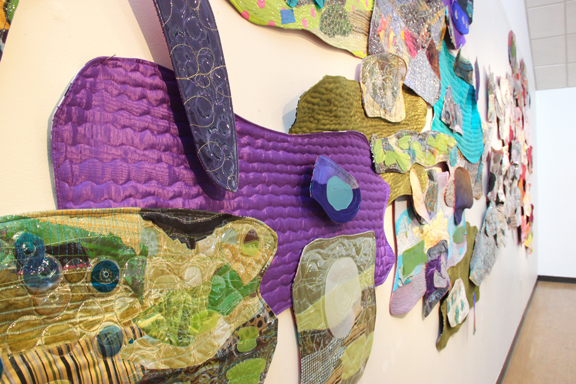 Wash & Wax, the collaboration between Leisa Rich & myself of abstract pieces inspired by images taken in a car wash, is traveling to the Irving Arts Center in Irving, Texas, May 21 – July 3. The reception is June 26th 2:00-4:00pm. If you’re in the area, please visit the exhibit! It’s a great show, we have a new piece added to the collection, and the huge wall piece looks different in every installation.
Wash & Wax, the collaboration between Leisa Rich & myself of abstract pieces inspired by images taken in a car wash, is traveling to the Irving Arts Center in Irving, Texas, May 21 – July 3. The reception is June 26th 2:00-4:00pm. If you’re in the area, please visit the exhibit! It’s a great show, we have a new piece added to the collection, and the huge wall piece looks different in every installation.
http://monaleisa.com/wash-wax-collaboration/
http://www.irvingartscenter.com/event/wash-wax-a-collaboration/

The Space In Between
0I find myself currently in the space in between. I accomplished so much work in January and February, and I now find that my creative self is requiring a break. I’ve been trying to cajole it into motion with small projects, leafing through pictures, reviewing calls for entry — it’s just not going anywhere right now. And that’s fine. Right now I have house company, and I’m enjoying doing for them. My studio went from looking like a train wreck a couple of weeks ago to a point now where it’s almost sterile. I put away all of the fabric from my last two projects as well as a bunch I got for Christmas. At least this gives me time to finish my taxes.
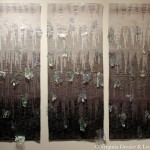 Leisa Rich & I decided to make one more piece for the Wash & Wax show exhibiting at Hammond Gallery at Jacksonville State University, thinking that the space was large enough to accommodate another piece. (By the way, we were wrong and ended up deleting a piece from the show for space limitations.) It’s a triptych in all grays — but with blue and green nail polish painted vinyl appliqués on the top. It’s much quieter from the other pieces but is striking on its own. I have a created a page for Dripped here.
Leisa Rich & I decided to make one more piece for the Wash & Wax show exhibiting at Hammond Gallery at Jacksonville State University, thinking that the space was large enough to accommodate another piece. (By the way, we were wrong and ended up deleting a piece from the show for space limitations.) It’s a triptych in all grays — but with blue and green nail polish painted vinyl appliqués on the top. It’s much quieter from the other pieces but is striking on its own. I have a created a page for Dripped here.
While we were in Jacksonville, we had a one-day workshop for the art students. They do not currently have a textile program, but it was mind-blowing to me what these young adults could do with fabric in such a short period of time.
This is one of the students next to Bryce Lafferty, one of the professors who also curated our exhibit. The student is learning on to draw using one of Leisa’s sewing machines, and Bryce is working on a hand-sewn 3-dimensional piece.
Another one of the students, perfectly comfortable using the sewing machine as he would a pencil.
This is Brittany, who I predict is a future fabric stash-er in the making. I spent some time talking with Brittany. She’s incredibly talented. She’s graduating in May, and I hope that she finds the perfect place to grow in her artistic journey after graduation.
This particular piece is 2-d but organically shaped.
Hammond Gallery is newly renovated, and it’s a gorgeous gallery space. This is the entry with Entry Point above the guest book.
The large wall was reserved for Industrial Car Wash. It’s in a completely different composition than how it was presented at Abernathy. It has interchangeable pieces so it can fit different spaces. Given that the wall was a little smaller than the one we used at Abernathy, it is taller and reaches almost floor to ceiling.
Next to it is Skitter.
On the other adjoining wall are 6 of the photographs and 6 of the Micro Bubble Series. We actually had 8 of each but felt the wall was too crowded with 2 more rows.
Next to Skitter and covering the back entrance is Drive Thru Slowly made from actual car wash strips.
A far corner has Polish on the left, the 2 remaining photographs and 2 remaining Micro Bubbles, and then Leisa and I decided to bring individual pieces of our work for comparison to the collaborative work. Leisa brought Placid which we placed sculpturally on a pedestal (although it can also hang on the wall). I didn’t get a close-up picture of it, but you can find it on Leisa’s website here.
My piece is a self-portrait entitled The Canary. You can read more about it here.
This is a pic taken during the reception. From the left, Blurred Vision, Agitated, and Bubble Bath.
This is an awesomely cool panoramic shot of the gallery that Leisa took.
And this is a side view of Dripped. It was at the far end and couldn’t be stretched into the panoramic. You can see the blue and green nail polish accents a little better in this shot.
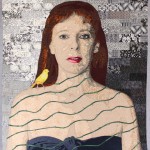 And as I mentioned before, the other piece that I hurriedly finished in time to be finished for the JSU show was my self-portrait, The Canary.
And as I mentioned before, the other piece that I hurriedly finished in time to be finished for the JSU show was my self-portrait, The Canary.
This one was really tough to photograph, and I’m not sure how well I succeeded. I was considering purchasing an external flash, but now I’m leaning towards using a local photographer that I’ve been introduced to that I think would do a better job of photographing my work. He essentially creates a white box — but a whole room like that, and then shoots through a pinhole. He also knows exactly the angles to set up the lights so that you’ll still see the texture of the surface of the work. I’ve photographed my own work enough to appreciate that the man really knows what he’s talking about.
But now here I am. I went from insanely busy finishing work for the opening at the JSU and preparing for the workshop — to nothing. I am in between. I think I’ll just enjoy it for a while.

Finishes
1 I have been working a blue streak in the studio lately. Not only did I finish The Canary, I also worked with Leisa to make 5 more small pieces for the Micro Bubbles Series (so we’d have 8 total for the JSU show) AND a large triptych for the Wash & Wax show opening at Hammond Gallery at Jacksonville State University on Thursday.
I have been working a blue streak in the studio lately. Not only did I finish The Canary, I also worked with Leisa to make 5 more small pieces for the Micro Bubbles Series (so we’d have 8 total for the JSU show) AND a large triptych for the Wash & Wax show opening at Hammond Gallery at Jacksonville State University on Thursday.
You can see The Canary on its new page here, and you can see the new Micro Bubbles Series II here — scroll down to the bottom to see Series II. I don’t have a pic of Dripped yet. It’s too large for my studio, but I’m planning to take pics of tomorrow once it’s hung at the gallery tomorrow.
The university has unfortunately changed the opening reception to invitation only. They will, however, have a public closing reception on April 7th, and the show will be open the entire month of March (after tomorrow when it’s hung). I have several friends in the area since I used to live near there that I hope will go see the show.
A friend of mine has asked me to explain how I do facings. I took pics and then decided maybe someone else would like to see how they’re done.
I started doing them during the Wash & Wax series. They give a much cleaner look than a binding, and they’re much easier on the fingers since you’re sewing through less layers. It was also the perfect finishing technique for pieces that had a lot of vinyl on them. I couldn’t iron a binding back from off the side of vinyl or it would melt the vinyl, but I had no problem ironing vinyl from the back of the piece while attaching facing.
I cut 2″ lengths for the four sides as well as 4 3-3/4 inch squares. The square is used in the corners, and the bias edge is a blessing.
Mark the top of the quilt with the finishing lines. I mark a rectangle with squared up corners (which with a large piece can be more easily said than done). Press each of the four squares in half. Then pin them into the corners that you’ve marked and sew them on with a 1/4″ stitch from the outside edges.
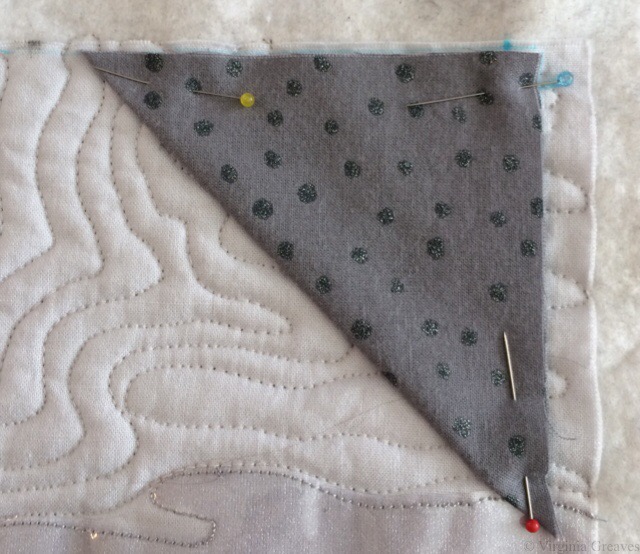
Take the 2″ strips and sew them together to make them long enough for each side (not all the way around). Fold back 1/4″ to the wrong side and press. Then I like to add 1/2″ fusible strips to hold down that 1/4″ that I’ve just folded back. Leave the paper on.
Then pin the facing strip to the sides — but don’t go all the way into the corner. I’m further over here to the left than I need to be. The folded bias square underneath is going to hide the edge anyway. It’s going to be on top after all of this is flipped to the back. After I made this one, I didn’t put the facing strip as far over on my next piece and had less bulk in the corner — which made turning the corner inside out easier.
Sew the 2″ strips to the front of the quilt, right sides together. The folded long side with the fusible will be on the opposite side.
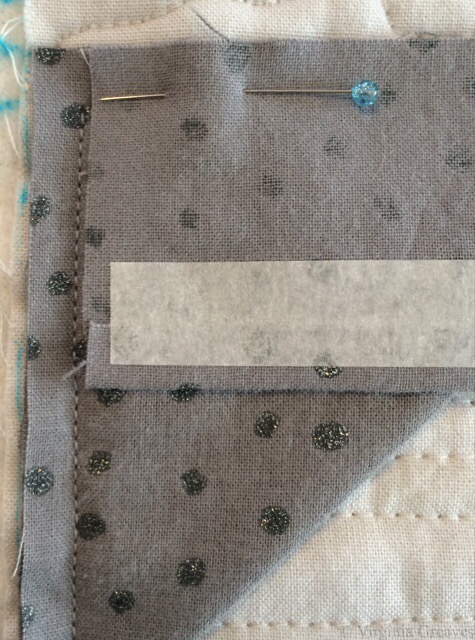
Then press the strips open. Here, you see the top facing pressed open. The right side strip was pressed open and then was stay stitched about 1/8″ from the fold. That’s the next step. Stay stitch all the way around. It makes it easier for the facing to pull to the back. (Lock your stitches at each beginning and ending.)
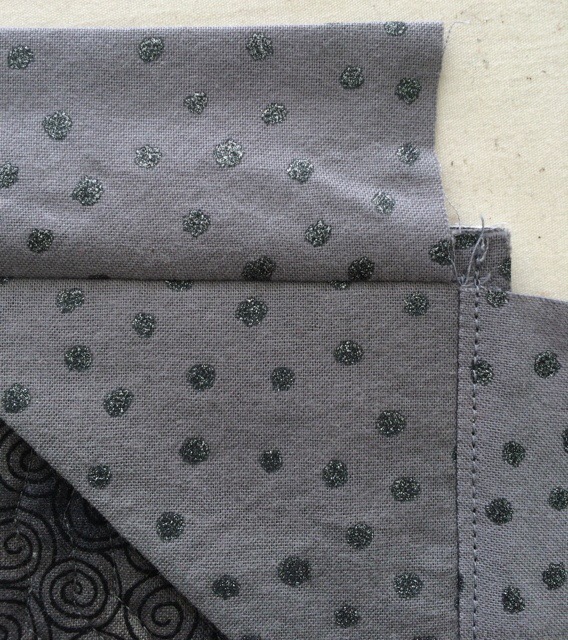
At this point, I cut a small strip of 1/2″ fusible and press it on to the folded edge of the square in the corner. Again, leave the paper on.
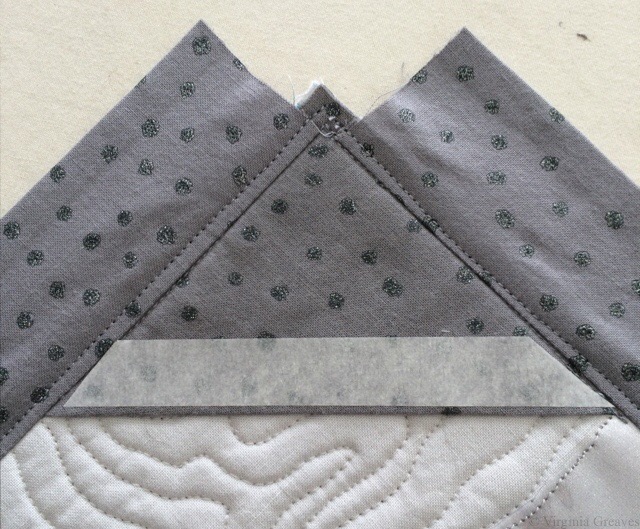
Then turn to the back. Turn the corners inside out.
Then take the paper off the fusible on one strip on one side. Using your iron and steam, pull the facing to the back and fuse down. Don’t worry about the corners until all of the sides are done.
Then take off the paper on the next strip and pull it down. Steam is your friend. The fusible will hold down the edge. If the facing isn’t straight, rip it off, reposition it, and re-steam it in place.
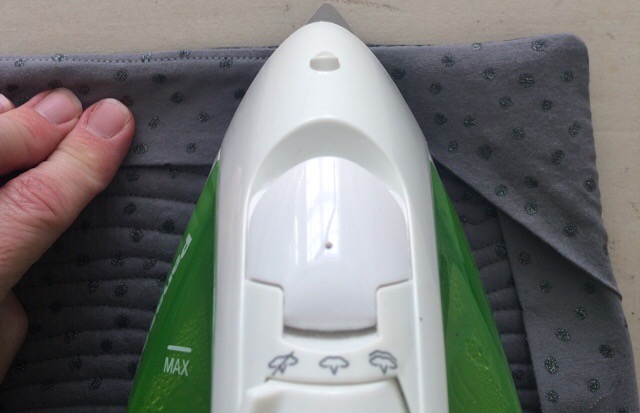
When all four sides are down, work on each corner. Take off the paper strip underneath and fuse it down. The steam will help the bias lay down if it’s a little wavy on that edge.
Notice that I used the same fabric for the backing, the facings, and the corners. I also used the same fabric for the sleeve. It gives it a clean look on the back.
I love using the fusible to hold everything in place until I can hand sew it down — which is the next step. I used to use the clear Elmer’s glue on bindings to hold everything in place before hand sewing, but I found that after a few years of travel, my bindings would begin to wrinkle. I think that even though the glue is water soluble, it wasn’t entirely washing out (even though I would soak my pieces in tubs of water for a while). Over time, it was drawing the fibers together — like a starch would. So it occurred to me to use fusible. It’s all over the front of my work — might as well use it on the back as well. And I know what to expect from it over time.

Then add the sleeve, leaving 1/2″ from the top from the fullness in the sleeve (I always allow 1/2″ of fullness for any thickness in the hanging device).
The first few times I did a facing, I topstitched all the way around from the front to the back. The thread color became an issue as I went around, so I didn’t care for that as much. The stay stitching accomplishes the same thing, and it’s invisible from the front.

















